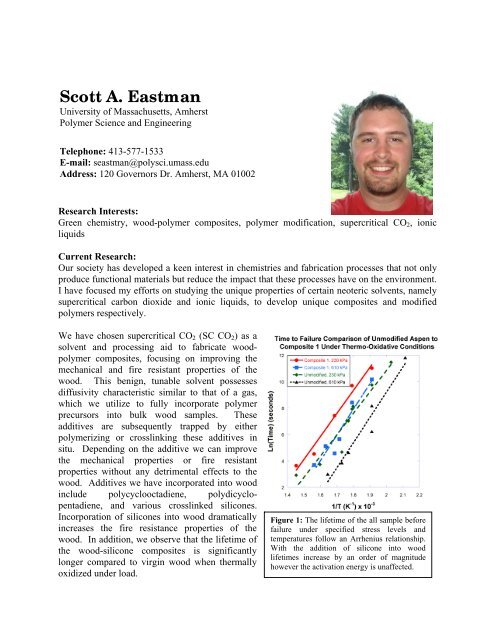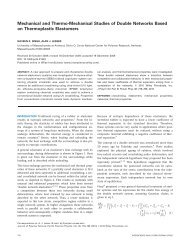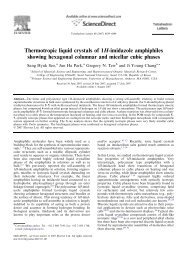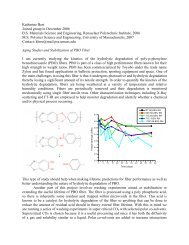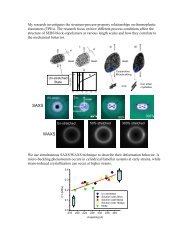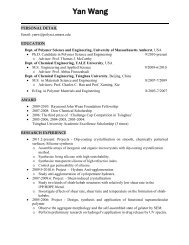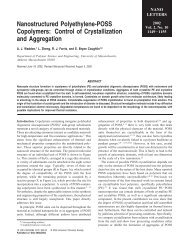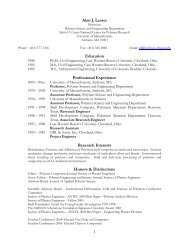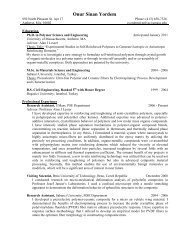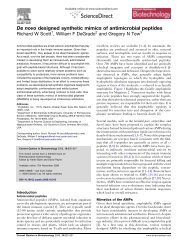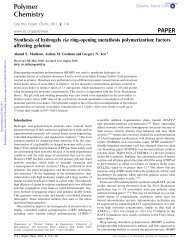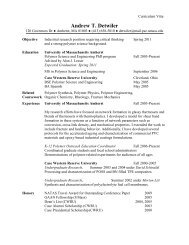Scott A. Eastman - Polymer Science and Engineering - University of ...
Scott A. Eastman - Polymer Science and Engineering - University of ...
Scott A. Eastman - Polymer Science and Engineering - University of ...
Create successful ePaper yourself
Turn your PDF publications into a flip-book with our unique Google optimized e-Paper software.
<strong>Scott</strong> A. <strong>Eastman</strong><strong>University</strong> <strong>of</strong> Massachusetts, Amherst<strong>Polymer</strong> <strong>Science</strong> <strong>and</strong> <strong>Engineering</strong>Telephone: 413-577-1533E-mail: seastman@polysci.umass.eduAddress: 120 Governors Dr. Amherst, MA 01002Research Interests:Green chemistry, wood-polymer composites, polymer modification, supercritical CO 2 , ionicliquidsCurrent Research:Our society has developed a keen interest in chemistries <strong>and</strong> fabrication processes that not onlyproduce functional materials but reduce the impact that these processes have on the environment.I have focused my efforts on studying the unique properties <strong>of</strong> certain neoteric solvents, namelysupercritical carbon dioxide <strong>and</strong> ionic liquids, to develop unique composites <strong>and</strong> modifiedpolymers respectively.We have chosen supercritical CO 2 (SC CO 2 ) as asolvent <strong>and</strong> processing aid to fabricate woodpolymercomposites, focusing on improving themechanical <strong>and</strong> fire resistant properties <strong>of</strong> thewood. This benign, tunable solvent possessesdiffusivity characteristic similar to that <strong>of</strong> a gas,which we utilize to fully incorporate polymerprecursors into bulk wood samples. Theseadditives are subsequently trapped by eitherpolymerizing or crosslinking these additives insitu. Depending on the additive we can improvethe mechanical properties or fire resistantproperties without any detrimental effects to thewood. Additives we have incorporated into woodinclude polycyclooctadiene, polydicyclopentadiene,<strong>and</strong> various crosslinked silicones.Incorporation <strong>of</strong> silicones into wood dramaticallyincreases the fire resistance properties <strong>of</strong> thewood. In addition, we observe that the lifetime <strong>of</strong>the wood-silicone composites is significantlylonger compared to virgin wood when thermallyoxidized under load.Figure 1: The lifetime <strong>of</strong> the all sample beforefailure under specified stress levels <strong>and</strong>temperatures follow an Arrhenius relationship.With the addition <strong>of</strong> silicone into woodlifetimes increase by an order <strong>of</strong> magnitudehowever the activation energy is unaffected.
10.80.60.40.20365031502650215016501150650Our second effort has been focused onmodifying polymers in ionic liquidsolvents. Compared to the tens <strong>of</strong>traditional organic solvents now used, thereare hundreds <strong>of</strong> ionic liquids commerciallyavailable with a wide range <strong>of</strong> differentproperties. If these ionic liquids were thenmixed into a binary ionic liquid solution,hundreds <strong>of</strong> thous<strong>and</strong>s <strong>of</strong> ionic solutionswith hybrid solvent properties can beimagined, making this class <strong>of</strong> solventsextremely tunable. In addition to thetunability <strong>of</strong> these solvents, they possess negligible vapor pressure which reduces the hazards <strong>of</strong>h<strong>and</strong>ling <strong>and</strong> flammability commonly associated with traditional organic solvents. We areinterested in conducting polymer modifications in ionic liquid solvents <strong>and</strong> explore their viabilityas replacements for traditional solvents. Observations have shown that in some cases these ionicFigure 2: ATR-IR <strong>of</strong> unmodified poly(vinyl alcohol) <strong>and</strong>PVOH modified with an acid chloride at three differentreaction conditions indicates that the esterification occursin an ionic liquid solvent.liquids not only act as a solvent but acatalyst as well. Ongoing efforts willstrive to quantify the kinetics <strong>and</strong>efficiency <strong>of</strong> several chemicalmodifications in ionic liquids.


